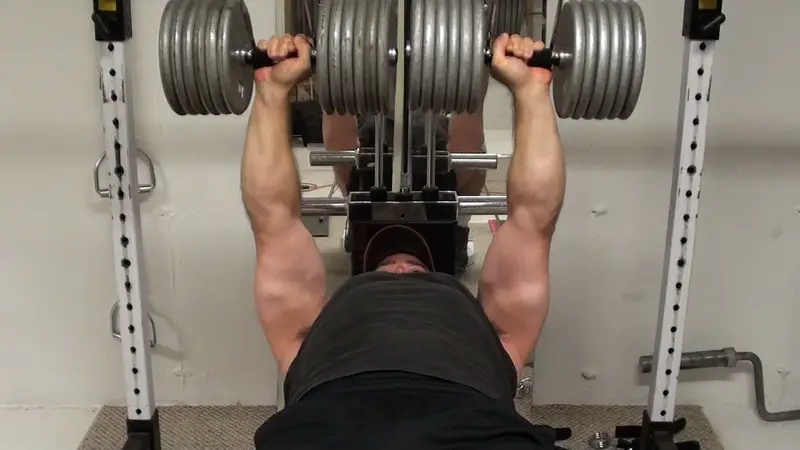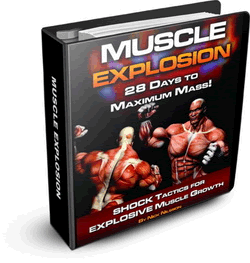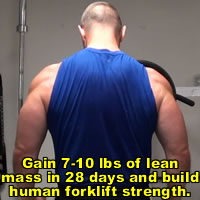By Nick Nilsson
Author of Muscle Explosion! 28 Days to Maximum Mass
This is one of THE single most powerful training techniques that I've ever discovered for making rapid gains in strength in a single exercise.
It's elegant in its simplicity, brutal in its execution and quite literally ASTONISHING in its effectiveness.

This technique is used in my advanced muscle-building program "Muscle Explosion - 28 Days to Maximum Mass" and believe me...it's TOUGH and it works like CRAZY.
I'll tell you right now, this will blow the doors off any preconceived notions you might have about training volume and how the body can respond and adapt to it.
The very first time I came up with this technique, I used it to do dumbbell shoulder presses. It was a Friday afternoon workout, and I did a set of presses for 8 reps with a pair of 60 lb dumbbells.
On Monday, only a few days later, I pressed 80 LB DUMBELLS for 11 REPS - same exercise, and using strict form. That was a 25% increase in strength in only a matter of 4 days!
So what happened in that one single workout that gave me such a HUGE increase in strength in only a matter of days?
I'm going to tell you...
I call it "Compound Exercise Overload." And if you've hit a plateau in ANY exercise, this technique WILL shatter it.
Basically, you're going to take a single compound exercise (a.k.a. multi-joint exercise like bench press, squats, deadlifts, barbell rows, shoulder presses, close grip presses, etc.) and do ONLY that single exercise for 40 MINUTES straight.
And that's not even the brutal part...
The brutal part is...you are only allowed 30 seconds of rest between sets...
And, here's the other brutal part...you're going to end up doing between 50 to 70 sets with NEAR-MAXIMAL WEIGHTS (relatively speaking - I'll explain below) of that single exercise for the ENTIRE WORKOUT.
This is one of the toughest workouts you can do (when you do it right) but you WILL be rewarded with results.
Compound Exercise Overload works to increase strength in four primary ways:
1. It focuses your nervous system on a single specific exercise, i.e. "greasing the groove" at a specific rep range. No competing training stimuli here, just very specific focus - it's one of the reasons Olympic lifters only use a few lifts in their training. It's also one of the reasons they can lift such extraordinary amounts of weight.
2. It allows you to have a LOT of practice lifting heavy weight - this helps you to perfect your form and become more efficient with your lifting technique.
3. The high volume of training (those 50 to 70 sets you're going to do) creates an emergency situation in your body which forces rapid adaptation by your body (both in muscle and connective tissue).
4. The high volume also forces a tremendous amount of blood into the target muscle group, which helps drive nutrients into those target muscles, which helps them recover and grow.
Combine these four factors and you've got one POWERFUL workout.
How to Do Compound Exercise Overload Training:
This technique is best done at a time when your gym is not very crowded. You're going to be taking over a single exercise area for the entire 40-minute workout.
First, select a compound exercise to work with. We'll use the bench press as an example here. In actuality, you can use this technique with almost any exercise, whether it be compound or isolation (single joint). I refer to this as Compound Exercise Overload because it's most effective when done using a compound exercise like presses, rows, deadlifts, squats, etc. Isolation exercises can be used, but the effects won't be quite as dramatic in terms of strength and muscle increases.
So get your exercise set up. If you're doing bench press, I HIGHLY recommend doing it in the power rack with the rails set up. That will allow you to use maximum weights without having to worry about being crushed or having to use a spotter the whole time.
If you don't have a rack to use, the other option is to do dumbbell presses. With dumbbell presses, if you can't complete a rep, you can always just set the dumbbells down.
Do a warm-up before getting started - whatever you prefer to do for a warm-up is fine. I like to do some general movements (like push-ups or a few pull-ups or a couple of minutes of walking on the treadmill) then a few light sets of the specific exercise I'm going to be working - nothing that will tax the body for what's to come.
With Compound Exercise Overload training (CEO, for short), I encourage you to use a stopwatch, regular watch or other form of timer.
If your gym has a clock with an easily readable "second" hand, that will be fine, too. Otherwise, you're going to have to count your 30 seconds of rest in your head, which is not as accurate (plus that 30 seconds will tend to turn into a LOT longer as you go through the workout and it's critical to keep it constant).
You're going to start with a weight you could normally do for about 6 reps or so. Start your timer or note the time on the clock because you're going to be doing this exercise for 40 minutes straight.
Lie down and perform ONLY 3 REPS with that weight, even though you COULD do six.
DO NOT go to failure on this first set...or on ANY set.
Now re-rack the weight and rest 30 seconds. Lay back down and do 3 more reps. Rest 30 seconds. You are going to repeat these 3 rep sets with those 30 seconds of rest until you are unable to get 3 reps with that weight anymore. This could take anywhere from 2 to 10 minutes, depending on the exercise and the amount of weight you're using.
The set where you only get 2 reps, Stop and remove 10 lbs each side of the bar (If you started with 245, you now have 225). Start again doing 3 reps sets and continue with 30 seconds rest period. Drop the weight by 20 lbs whenever you can't complete 3 reps during a set.
(Note: if you're using isolation exercises with lighter weight, you can drop the weight by 10 lbs and take 20 seconds rest).
** Be sure to stick with 3 reps on each set - no more, no less (until you get to the point where you can't get 3 reps). Your body hits a rep-range groove and will acclimate to it very quickly. It keeps your nervous system efficient. **
On the final set (after 40 minutes are up) rest for two full minutes (so very generous...) then lay back down crank out as many reps as you can with the same weight you just ended with. You'll find that can probably get 6 to 8 reps on that set, just because of the increased rest period.
This training makes use of neuromuscular specificity to teach your body the absolute most efficient way to perform a single exercise. Your body will learn to fire the exact sequence of muscle fibers it needs to do the exercise most efficiently, making fast strength gains possible.
Therefore you MUST use perfect form on every rep of every set...no exceptions. If your form starts to break, end the set and reduce the weight before you start your next set.
The idea here is to overload your body with VOLUME, not intensity.
Training Notes
-
Don't use different variations of the same exercise (e.g. don't start with incline bench then go to flat bench). It's important to use the EXACT SAME exercise the whole 40 minutes for maximum adaptive response.
-
Do your best with the 30 second rest. This rest period will naturally increase during the times when you're making weight changes but even then, try to keep it as close as possible. Just do your best to stick with the 30 seconds.
-
When doing this technique with a barbell exercise, I like to load the bar with small plates as I load it for my starting weight. For example, if you're starting with 225 lbs on the bench press, don't just throw two 45 lb plates on either side. You'll be pulling a pair of those 45's off pretty quick.
Instead, put one 45 lb plate on either side, then a 25 lb plate, then a 10 lb plate then two 5 lb plates. It's the same weight but when you can no longer hit 225 lbs for 3 reps, all you need to do is pull a small 5 lb plate off either side. This is much easier than pulling 45's off either side then loading 35's and a 5 back on.
-
Be sure to keep track of your starting weight and ending weight so you know what your numbers are and can improve on them the next time you do this technique. I recommend you take a full 2 days off training after you get done with this one.
To maximize the adaptive response, those 2 days off are CRITICAL.
-
If you're going to try this technique with a training partner, it helps if they're the same strength level as you are (especially if you're doing barbell work). If you're doing dumbbells, it's not as critical as you can just grab different sets of dumbbells.
With a partner, you're basically going to be going back and forth with no real break. Thirty seconds is not a lot of time. If you're working with a barbell exercise and you need to switch weights, the moment you finish your set, you need to both start switching weights before your partner starts. When he/she finishes, you need to jump back and switch again.
It can be done (I've done it a few times training with another person) but it does make it harder to execute, depending on the exercise.
Conclusion:
If you're looking for a FAST way to get past a plateau and build your strength, I don't think there's any program out there better than Compound Exercise Overload Training. It won't be easy but the results are well worth it.
And if you're interested in reading more about the full program that this powerful technique fits in to, go to: "Muscle Explosion! 28 Days to Maximum Mass".
You'll be doing this technique FIVE DAYS IN A ROW in this program...it's insane, yes, and incredibly effective. I've seen gains (lean mass) of 6 to 10 lbs in one week in some individuals. This program is for those who are really interested in pushing themselves to their physical limits.
![]()
More From Fitstep.com
| You're Breathing Wrong...Here's Why... | |
| Full-Body 15-Minute Fat Loss Circuit With ONE Dumbbell | |
| How I Got My Butt Kicked By a 68 Year-Old Woman | |
| Speedskater's Secret For a Bigger Butt |
Share This Page...
---
Home -> Muscle and Strength -> Workouts -> CEO Training




